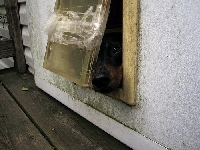
Tips for installing a pet door at home so your dog or cat will thank you
So, you’re interested in installing a pet door at home? Well, you’ve come to the right place. Below, we’ll take a look at proper measuring techniques, beginning resources for those looking to complete the project themselves, as well as alternative ways — such as handymen, installers, and/or suppliers — for installation which requires less manpower and know-how on your part.
Proper Measuring Techniques
It all starts with measurements of your animal. And a unique way to measure your animal is to not measure them directly. Say what? Simply open a doorway as far as it takes for your furry friend to meander on through. Use a treat if need be to entice them to walk through. Then just measure the width of the open area. That simple.
So, when you measure the gap in which your animal fits comfortably through you’ve got the width for your petdoor flap. The flap is what the animal will fit through after installation in order to head outside to do their business.
In terms of height, here you may actually measure your animal. To find out where the top of the flap should be placed on a door, window, or wall, measure from their shoulders — known as the withers — down to the ground. Add an inch or two to that height calculation in order to give them a little more wiggle room. Thus, you now have your height and width of your prospective opening.
~
For the lower section of the flap, lower is actually better, according to the professionals. The step-over as it’s called should not exceed 1/3rd of the animal’s height at the withers.
For the DIY Subset
For those interested in taking this project upon themselves, there are a variety of great resources to assist with the measuring, framing, and construction (i.e.: hole-cutting) process. You can use a more basic starter guide for owners or a very detailed guide for owners looking to install their new pet door at home.
Options include:
- Purchasing or using an existing one; you’d use the measurements you took of your animal and then would cut the necessary area out of it.
- Many projects include templates for proper placement of the cuts; by using this template, owners can follow along on the Lowes.com set of instructions in order to cut the perfect hole.
The Lowes site is probably the best option for an in-depth guide for those looking to take the project upon themselves without any additional assistance. And for those looking at other, less hands-on options, keep reading.
Alternative Options
Those interested in a less strenuous approach can find a variety of options available to them when it comes to installation. Learn about the different installation categories such as:
- Walls
- Windows
- Sliding glass
- Wood or metal
- Screen
- Electronic
The electronic variety is an interesting option for owners as it’s made with safety in mind. You can purchase an electronic, motorized, or even magnetic version in order to keep stray critters, other neighborhood cats/dogs, and even potential robbers out.
There are options, too, when it comes to the act of installation. Ideas for professional pet door installation can be a good place to start. Handymen and other installers will assist homeowners in the installation process. It will thus simplify the construction, limit labor on your part, and assure a perfect fit within your door, window, or wall.
Extra Tips
For some animal training techniques, head over to the training section to learn better ways in which to train your animal to use the newly designed opening while you’re away. Great deals can be also found for buyers; the new purchase doesn’t have to break the bank. Thus, there are a variety of ways in which to install your new animal opening. Depending upon skill-set, available time in your busy schedule, and cost, you can either choose to do it yourself or find assistance in the matter.

